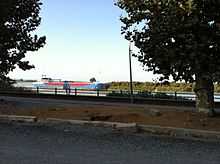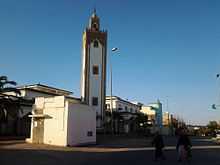Kenitra
| Kenitra | |
|---|---|
 Kenitra | |
| Coordinates: 34°15′N 6°35′W / 34.250°N 6.583°W | |
| Country |
|
| Region | Gharb-Chrarda-Béni Hssen |
| Province | Province of Kénitra |
| Population (2004) | |
| • Total | 359,142 |
| • Population Rank in Morocco | 9th |
| Time zone | WET (UTC+0) |
| • Summer (DST) | WEST (UTC+1) |
Kenitra (Moroccan Arabic name: القنيطرة, transliterated: Q'nitra, the little bridge) is a city in Morocco, formerly (1932–1956) known as Port Lyautey. It is a port on the Sebou River, has a population in 2004 of 359,142 [1] and is the capital of the Gharb-Chrarda-Béni Hssen region. During the Cold War Kenitra's U.S. Naval Air Facility served as a stopping point in North Africa.
History

Ancient History
The history of the city begins with the foundation of a trading-post by the Phoenicians, known back then as Thamusida. Under the Antonine Dynasty, a Venus temple was built there.
Before the French protectorate, there was only a kasbah in the area where the modern city can today be found.
French Protectorate and modern times

In March 1912 the French government and the Sultan of Morocco, Abd-El-Hafid, signed the Treaty of Fez. Because of his growing unpopularity, the Sultan asked the French government for protection against the Berber rebel tribes surrounding Fez. France appointed Hubert Lyautey resident-general in Morocco.
General Lyautey restored peace and order to the country after crushing the tribal uprising. After safely moving the Sultan from Fez to the current capital city, Rabat, Lyautey began his task of civilian administration.
One of the first preoccupations of General Lyautey was to build ports along the inhabitable Atlantic coast where there were no natural harbors. He established Kenitra in 1912 as a French military fort and town. The port at Kenitra, at the mouth of the Sebou river, was opened in 1913.[2] It soon became the best river port in Morocco.[3] Kenitra draws its name from a culvert built at Fouarat lake upstream of the kasbah. This culvert was destroyed in 1928. In 1933, the French officially named the locale "Port Lyautey".
It was renamed "Kenitra" in 1956 as Morocco gained its independence. Kenitra has grown rapidly to be a shipping centre for agricultural produce (mainly fruit), fish, timber, and lead and zinc ores. The city’s industrial area lies upstream of the port.
U.S. Naval Base

In November 1942, after Operation Torch, the Americans captured the Port Lyautey French fighter base as a military base, named Craw Field. The Navy ran the base until 1947, when the State Department negotiated reversion of control to France. In 1950, a $23,000,000 expansion was authorized, but then the Korean War diverted resources. In the 1950s, nearly 10,000 persons were on the base making it the largest aggregation of Americans in any one overseas base outside Japan. Later, the base at Kenitra was expanded to become a U.S. Naval Air Station.[4]
The base was shared by both the USA and Morocco through the Cold War. A small Navy communications out-station at Sidi Yahia closed in the mid 1970s. The Air Station was closed in 1991.
Population
| 1982 | 1994 | 2004 | 2010 |
|---|---|---|---|
| 188,194 | 292,453 | 359,142 | 931,027 |
Areas and neighborhoods
- Médina
- Khabazate
- La Cigogne
- La cité
- Modern city
- Mimosa
- Ville Haute
- Popular districts
- Saknia
- Ouled Oujih
- Maghrib al Arabi
- Residential districts
- Bir Rami
- Val fleury

Colleges and universities
- Université Ibn Tofail (UIT)
- ENCG Kénitra (École Nationale de Commerce et de Gestion de Kénitra)
- HECI Kénitra (Hautes Etudes Commerciales et Informatiques)
- ENSA Kénitra (École Nationale des Sciences Appliquées de Kénitra)
Transportation
The city is served by two railway stations: Kenitra-Ville and Kenitra-Medina. A shuttle train, TNR, connects the city, every 30 minutes, to Rabat and Casablanca.
A high-speed rail line to Tangier is planned to be completed in 2013 (see Kenitra-Tangier high-speed rail line).
Sports
Kenitra Athletic Club, KAC
In 1938, a group of Kenitra natives created KAC. This group of soccer lovers wanted to resist French domination in sports in Morocco. The team, made entirely of Kenitra natives, succeeded in reaching the premier Moroccan soccer league in 1956. In 1960, KAC won its first championship league of Morocco. KAC embarked in a journey of glories by winning the 1973-81-82 championship leagues and the 1961 throne cup. One name comes to mind when talking about KAC, Ahmed Souiri. He was a manager and coach who dedicated his entire life to training and inspiring young soccer players. KAC has produced many international soccer players who have enriched the Moroccan soccer team. Bouliahiaoui and Khalifa were among the players who helped the Moroccan national soccer team qualify to the second round of the World Cup finals in Mexico in 1986. Mohammed Boussati still holds a national record of goals by scoring 25 goals in one soccer championship season 1981-82.
Ajax Kenitra
The local indoor soccer club took a lead in representing Morocco in many international indoor soccer tournaments. Many tributes should be paid to Mohammed Nhaida for his role in managing the club.
Natives from Kenitra
Kenitra was the birthplace of:
- Saïd Aouita, Olympic athlete
- Amina Ait Hammou, Olympic athlete
- Youssef Chippo, International football player
See also
- Bouknadel
- Hubert Lyautey
- Battle for Port Lyautey
- Badr Hari
Notes and references
- ↑ "Recensement Général De La Population Et De L'Habitat De 2004". hcp.ma. Retrieved 2010-01-06.
- ↑ Kénitra depuis 1912 (French)
- ↑ In Morocco by Edith Wharton, New York: Charles Scribner's Sons 1920
- ↑ History of Port Lyautey
External links
| Wikimedia Commons has media related to Kenitra. |
- First site for the City of Kenitra
- Premier Portail d'information de La ville de Kenitra
- Entry in Lexicorient
- BTS Genie Informatique Lycee Technique Ibn Sina
- Association Nationale des Professeurs Agreges du Maroc - ANAPAM -
- Pictures of U.S. Naval base facilities in Kenitra
- Histoire de Kenitra / Port-Lyautey en images de 1911 au 1956
- http://mimouniouafae.webs.com/ photos de kenitra
Coordinates: 34°15′N 6°35′W / 34.250°N 6.583°W
| ||||||||||||||
